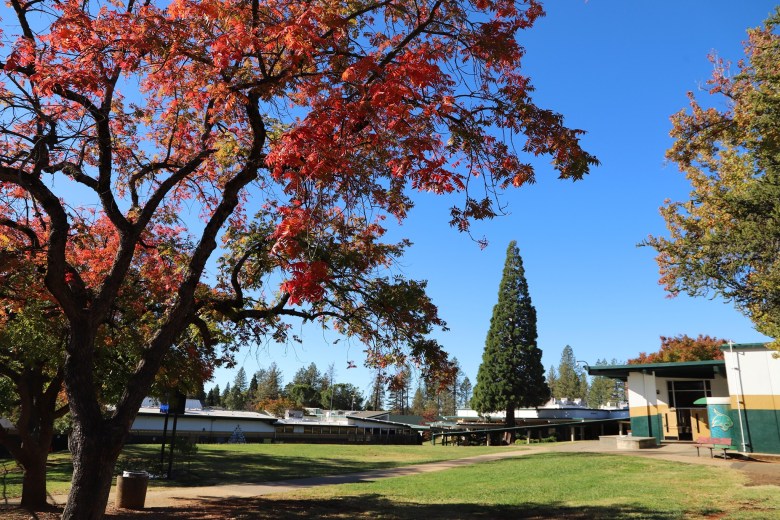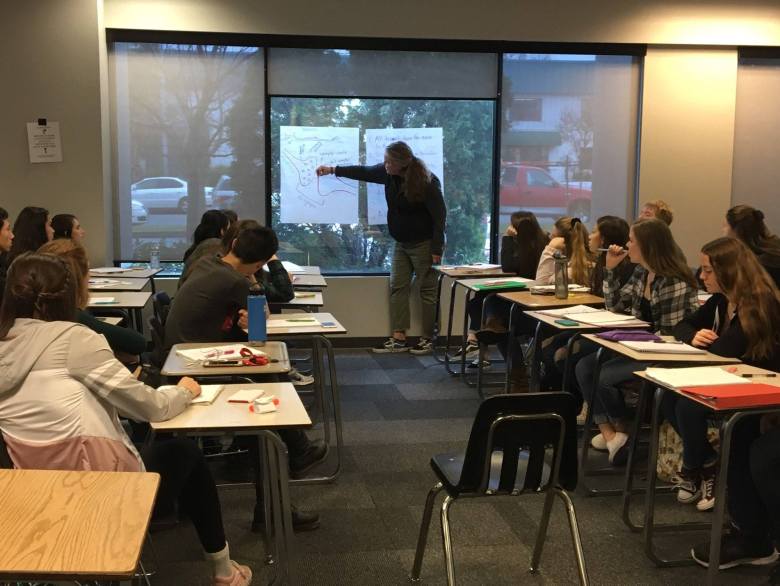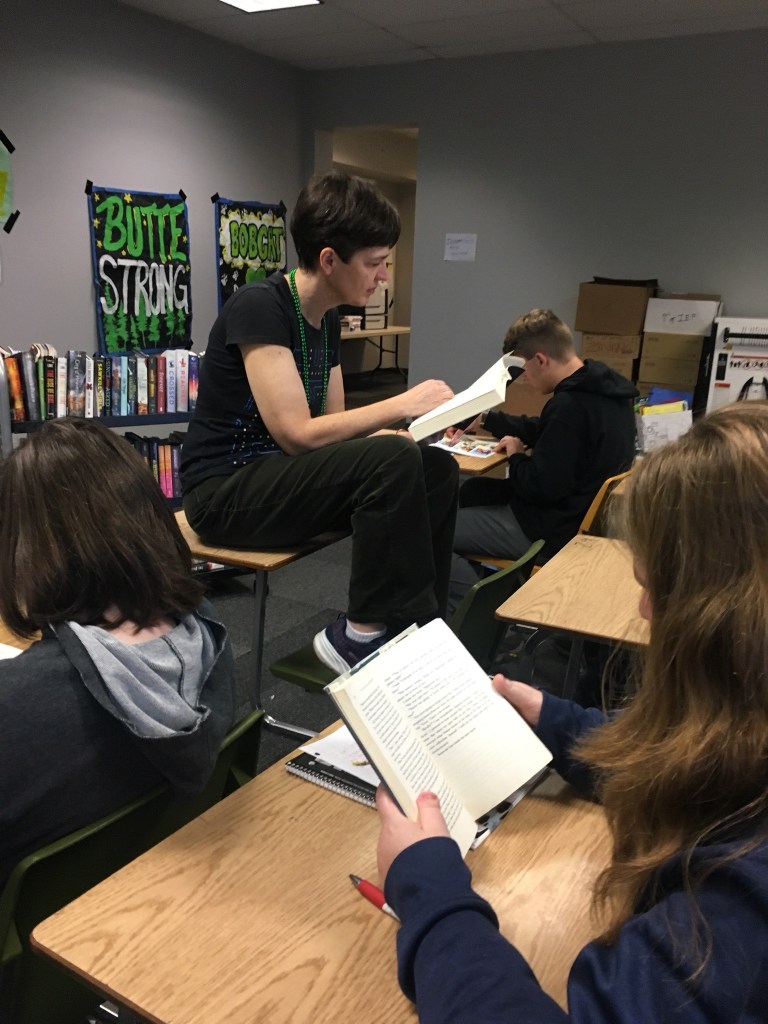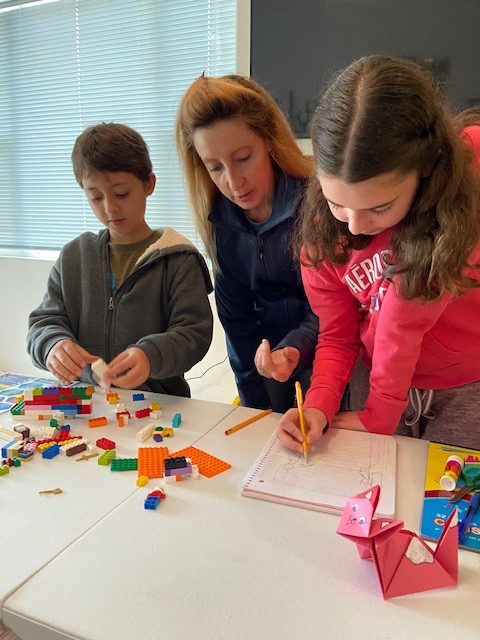This story was produced as part of the nine-part series “Are We Ready? How Schools Are Preparing – and Not Preparing – Children for Climate Change,” reported by HuffPost and The Hechinger Report, a nonprofit, independent news organization focused on inequality and innovation in education.

PARADISE, Calif. — The sky was a bright orange, betraying the likelihood of a small wildfire of the sort that occasionally flares near this town in the foothills of the Sierra Nevadas. But 11th grader Hannah Sperske was more worried about a chemistry test later that day, so she stuffed flashcards in her pocket and drove to school.

Sperske never made it to class that morning of November 8, 2018. When she arrived at Paradise High School, a campus of low-slung concrete buildings shaded by tall pines, her principal was yelling at kids to evacuate as embers the diameter of baseballs fell from the sky.
The Camp Fire incinerated Sperske’s house, the homes of most of her friends and her town of Paradise, California. It also left her anguished and angry. After the fire, she hated going to the “airport school,” the nickname for the temporary school space in an office building beside the town’s tiny airport. Flimsy foam dividers separated the classrooms, and it was hard to concentrate. Sperske got one of her first Bs, cried most days and could barely motivate herself to study.
“It was really weird to go from being the smartest person in my class and putting in the most effort to feeling dumb all the time, and unmotivated and not wanting to do anything,” said Sperske. “It was a 180 turn.”
A year and a half after the deadliest and most destructive fire in California history, students are coping with the psychological consequences of living through a megadisaster that sent them running for their lives. Apathy, anxiety and depression are up, educators here say, along with rates of parental alcoholism, drug abuse and divorce. Some kids still live in travel trailers and tents or make long commutes from towns 30 miles away. It’s a collective post-traumatic stress that has turned teachers into counselors and counselors into fire-trauma specialists and left students despondent and disconnected from learning.

“It’s not just your house that burned, it’s everyone’s,” said Hilary Ervin, a special education teacher who was raised in Paradise and whose grandparents opened a furniture store here in the 1950s. “As a mom, I want to fix it, as a teacher I want to fix it. But I can’t. I can’t give them a house. I can gather certain items, but I just can’t make everything better for everybody … I think it’s going to affect the town for a very long time.”
Are We Ready?
This nine-part series explores how we’re teaching through climate change. We report on how climate change emergencies are disrupting student learning, exacerbating mental health problems, devastating school infrastructure, and how the coronavirus pandemic is a preview of what education looks like in a climate emergency. We also look at how textbooks are coming up short in teaching kids about climate, how medical schools are preparing future doctors, and how despite the obstacles some educators are finding ways to give students skills they need to better protect themselves and their communities.
This sort of crisis is one that more school districts may experience as climate change elevates the risks of deadly wildfires, hurricanes, flooding and other extreme weather. In California, seven of the ten most destructive fires on record have occurred since 2015. In Paradise, although fires had hit the town before, in 2018 the drier climate and high winds helped turn a blaze ignited by power lines into a catastrophic disaster that killed at least 86 people and left thousands homeless.
After a natural disaster like the Camp Fire, rates of post-traumatic stress typically rise from 5 to 20 percent, although they can surge as high as 90 percent, depending on who is studied and how, says Elizabeth Haase, a psychiatrist who examines the psychological effects of climate change.
“I just think we’re in for a big storm for a while.”
Angel Allen-Clifford, school psychologist, Paradise Unified School District
Eric Eckhart, part of a fleet of a dozen counselors who came out of retirement to help after the fire, spent much of the year visiting classrooms, meeting individually with students and helping them process the fire’s aftermath. He uses humor and art to connect with them. Eckhart keeps a drawing of a fire truck in his office. The student who drew it after the disaster obsessively researched fire departments and found calm in creating the image of the truck as a symbol of safety.
“I have never worked in a situation where the collective stress level has been this high or this acute,” said Eckhart, who had retired in 2016 after 24 years with the district.
Related: Teaching global warming in a charged political climate
In 2019, Paradise was left with about 1,700 students, compared with 3,400 before the fire, but even with fewer students, it has been struggling to help kids cope with basic needs. In addition to bringing back retired counselors and training them in trauma, district and county leaders have organized a committee on teacher mental health and begun to offer mindfulness exercises for younger kids.
Before the Camp Fire, Butte County, where Paradise is located, had among the highest poverty rates of any county in the state. The wildfire further destabilized families and left them fighting with insurance companies and hunting for jobs after their workplaces burned down.
All around town, signs for wiped-out businesses — the House of Hair, the Health Mart, Paradise Inn — rise like gravestones. Only one of the district’s nine schools survived unscathed.

Teachers here say the fire transformed the way they teach. Wendy Marsters, who has taught science at Paradise High School for 23 years, said that after the disaster, her advanced biology class was determined to stay focused on the AP exam. But the rest of her kids had a difficult time with the basics. “It’s really hard to actively participate in learning when you are living in shelters, you’re living in friends’ houses, on couches, you are in hotels, you’re driving 45 minutes. They were very shell shocked,” she said.
She tried to make lessons as engaging as possible to give them some relief. But she taught more slowly than before, and even now she doesn’t get through as much material as she did pre-fire. Before every class, she reads the room for signs of anxiousness and depression, for sleepless students and kids who might be newly homeless.
On the one-year anniversary of the fire, rather than sticking to the lesson plan, Marsters decided that students would watch Bob Ross videos and paint.
“As a mom, I want to fix it, as a teacher I want to fix it. But I can’t.”
Hilary Ervin, special education teacher, Paradise schools
Jori Krulder, an English teacher at the school for 17 years, said she sees more Ds and Fs than ever before. But now she’s happy if a kid who has been withdrawn engages with an essay, even if the writing is off topic and doesn’t stick to the assignment.
On a recent morning, her tenth graders were discussing “Fahrenheit 451,” the dystopian novel of an America in which books are banned and “firemen” burn them. Krulder had been teaching the book when the Camp Fire hit, and she’d been reluctant to return to it because of the fire imagery, but her students insisted. On this day, she asked them to write the book’s themes on index cards and build small sculptures representing those themes from pipe cleaners and popsicle sticks.

They wrote things like, “Burning our way into destruction, if you burn away society, that destruction will take you with it,” and “Being awakened and seeing reality is important when there’s certain propaganda being spread.”
A natural disaster is just one way that climate change can produce emotional harms, mental health professionals say. Heat waves and air pollution contribute to brain inflammation that’s associated with higher levels of depression, behavioral disorders and other illnesses. And simply being aware of the warming climate and anticipating its consequences can provoke anxiety and grief, what some psychologists describe as “pre-traumatic stress disorder.”
“There’s children’s distress about this, [that] they are living in a world that’s going to get worse, not better, that adults have betrayed them and not provided for them,” said Haase, who serves on the Climate Psychiatry Alliance, a group that is trying to help people cope.
She likens this aspect of children’s experience of climate change to one common to victims of child abuse: Adults who dither and deny the climate crisis are akin to enablers, ignoring a dark secret and leaving kids with no one to trust. Young people might respond by shutting down, lashing out or becoming depressed, she said.
“I am just scared,” said Sabine Wolpert, a seventh grader at Salmon Creek Charter School in Occidental, California, which has been touched by three fires and major flooding since 2017. “I can’t really tell what my future is, what my future will look like, or how predictable it is, or how much I can trust the people who have the power to take the necessary actions or if it’s worth getting an education or learning things for the future if we’re on this path.”
“I have never worked in a situation where the collective stress level has been this high or this acute.”
Eric Eckhart, counselor, Paradise Unified School District
Wolpert said that participating in a climate action club at her school has helped her feel better, but not much, because she’s encountered so many adults who neglect the issue.
In Paradise, a politically conservative community whose population shrank by more than three-quarters after the Camp Fire, climate change is discussed little; when the topic does come up, it’s sometimes dismissed as “fake news.” Marsters, the Paradise High science teacher, said she doesn’t teach much on climate change because the state standards don’t prioritize it.
While California’s science standards are more explicit than those of many states when it comes to the topic, Marsters said she’d welcome state legislation like the bill introduced in January that would make climate change education a graduation requirement. The science textbooks in her classroom were published in 2008, years before the most recent scientific assessments underlining the extreme urgency of the climate crisis.
Related: The silence of school leaders on climate change
Some students and teachers are determined to find lessons from the fire beyond loss and despair.
Sperske, the Paradise High senior, said she’s relieved that grades are no longer her primary preoccupation. She feels more appreciative now, and does a better job of staying in touch with friends and family. “It changed me in a way that will change my whole life,” she said.
Her classmate Asiya Russo said students support each other in a way they didn’t before. The seniors set up a Snapchat group and message each other for help. Russo recently needed her car jumped and classmates responded immediately. “I get really nervous texting the chat because it’s such a big chat,” she said. “But the second you do everyone’s really supportive and helpful.”
What Paradise will look like in the future remains a big question. Some are hopeful that the town will rebound. Next to Paradise High School, two new houses are going up, a testament to the close-knit nature of the town that keeps some wanting to return. Tom Taylor, the school district superintendent, said he’s spoken with other districts that have survived disasters and that, based on those conversations, he expects the student body will grow slightly in a few years.

But the opposite could also happen. The calculus of the many students who moved to other towns after the fire yet decided to re-enroll in Paradise schools for continuity could change.
Either way, there’s a new crisis looming. Since the fire, the Paradise school district has continued to be funded at pre-disaster levels despite its smaller student body, through a provision known as “hold harmless.” But that money is ending, and this spring, roughly 30 school district employees were put on notice that they’ll lose their jobs next year. It’s the sort of funding crunch that more districts will face as emergencies shrink student bodies, destroy school infrastructure and create new needs for counseling, transportation and other services.
In Paradise, it’s unclear if the district can retain counselors like Eckhart beyond next year. The county has been raising philanthropic money to help them stay. Meanwhile, educators worry that the layoffs could send the district’s fragile educational gains of the past six months into a tailspin. “I just think we’re in for a big storm for a while,” said Angel Allen-Clifford, a school psychologist who has worked in the district for 22 years.
When school staff feel disheartened, Eckhart said he tries to remind them of their heroism on the day of the Camp Fire. “You guys had 3,000 students and hundreds of teachers, and everyone made it off the ridge. Nobody died, nobody got hurt,” he said. “That, to me, is a remarkable miracle.”
“I can’t really tell what my future is, what my future will look like, or how predictable it is, or how much I can trust the people who have the power to take the necessary actions or if it’s worth getting an education or learning things for the future if we’re on this path.”
Sabine Wolpert, seventh grader, Salmon Creek Charter School, Occidental, California
But how many more miracles can an increasingly chaotic world yield? Eckhart wonders. In parts of California, fire season now runs virtually year-round, multiplying the risks of calamity and leaving residents feeling defenseless against nature. Eckhart said he misses the days when earthquakes felt like the biggest threat. When he hikes in the mountains near Paradise, passing by other towns vulnerable to fire, he said he wonders if the earth’s paroxysms can still be survived.
“There are too many environmental factors that are creating this catastrophic area,” said Eckhart as he sat in his mostly bare office on the aged Paradise High campus. “It’s not a question of ‘if,’ it almost feels like, when . . .?”
This story about the effects of climate change was produced by The Hechinger Report, a nonprofit, independent news organization focused on inequality and innovation in education. Sign up for the Hechinger newsletter.




Thank you Caroline, for reminding me of a tragedy I’d forgotten. It makes me think about the new face of homelessness which always reflects the current conditions in our communities. The disorientation students felt returning to new locations to learn following the Paradise Fire make me wonder if reopening our schools too soon increases the magnitude of grief. Emergency preparations to continue education is A a point of focus that needs modernized attention. Relocating, rather than building back communities quicker, may not be the answer. Perhaps a new urban plan to climate catastrophes is next. I wonder what students would suggest if they were asked what their educational campus should look like following loss. Maybe larger counseling offices, safe places to play and areas to rest would arise. Desks and books after that. Thank you for this to think about.